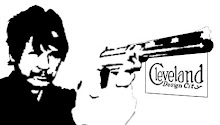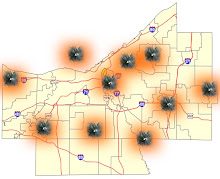I would encourage everyone to vote for BOTC's friend and classmate, Ken Gowland of Metrostudio, and his submission for the New Orleans Sustainable Design Competittion.
Ken and his family withstood Katrina's sacking of the city, the evacuation, and now is taking part in the vital re-building of the city.
Thursday, July 27, 2006
Thursday, July 20, 2006
A Delayed Campus-Making Tactic
How do you transform a loosely grouped ensemble of medical buildings into a "campus"?
Commandeer a major piece of city and federal infrastructure and transform the street, Euclid Avenue, into a organizational pedestrian spine. That is exactly what the Cleveland Clinic is studying and proposing.
The Clinic is a monster institution, possessing blocks and blocks of inner city Cleveland, abutting University Circle. The Clinic is the largest institution in the city and adds luster to the rusting hulk of this post-industrial region. To say the least, the hospital maintains a muscular presence.
Many were astounded by the brashness and scope of the plan, which would alter the urban landscape for over 20 city blocks. But this is in by no way a new tactic for institutions seeking to engender or further enhance the notion of "campus". Penn State turned a campus and State College Street into a Jefferson-inspired academic mall, a space now considered the main organizational element. Yale University has transformed New Haven streets into University campus walks, connecting Old Campus to Cross Campus and the Sterling Memorial Library. Case Western Reserve University has morphed alleys into student thoroughfares. And there are many other examples that escape me.
The scale of the endeavor is intriguing, as well as the retroactive urban design tactic that Peter Walker and the Clinic are employing. The deployment of a organizational element, a massive pedestrian mall, after over 90 years of campus development, overturns the normative methods of campus design. Instead of inducing the instant campus, the proposed plan suggests the acquisition of "campus" can be attained many decades after the planning and building begins.
Although the Clinic may be inciting a political firestorm, the methods and tactics that Peter Walker is employing are nonetheless interesting and deserve further critical scrutiny.
For more on the Clinic plan see Design Rag's take.
Commandeer a major piece of city and federal infrastructure and transform the street, Euclid Avenue, into a organizational pedestrian spine. That is exactly what the Cleveland Clinic is studying and proposing.
The Clinic is a monster institution, possessing blocks and blocks of inner city Cleveland, abutting University Circle. The Clinic is the largest institution in the city and adds luster to the rusting hulk of this post-industrial region. To say the least, the hospital maintains a muscular presence.
Many were astounded by the brashness and scope of the plan, which would alter the urban landscape for over 20 city blocks. But this is in by no way a new tactic for institutions seeking to engender or further enhance the notion of "campus". Penn State turned a campus and State College Street into a Jefferson-inspired academic mall, a space now considered the main organizational element. Yale University has transformed New Haven streets into University campus walks, connecting Old Campus to Cross Campus and the Sterling Memorial Library. Case Western Reserve University has morphed alleys into student thoroughfares. And there are many other examples that escape me.
The scale of the endeavor is intriguing, as well as the retroactive urban design tactic that Peter Walker and the Clinic are employing. The deployment of a organizational element, a massive pedestrian mall, after over 90 years of campus development, overturns the normative methods of campus design. Instead of inducing the instant campus, the proposed plan suggests the acquisition of "campus" can be attained many decades after the planning and building begins.
Although the Clinic may be inciting a political firestorm, the methods and tactics that Peter Walker is employing are nonetheless interesting and deserve further critical scrutiny.
For more on the Clinic plan see Design Rag's take.
Wednesday, July 12, 2006
Thanks for the interest, now get out of the way
This week's Crain's Cleveland Business publishes a letter to the editor concerning the potential changes with Cleveland's Public Sqaure (subscription needed). The authors--Mayor Debbie Sutherland (Bay Village), Martin Sweeney (Cleveland City Council), Andrew Roth (Notre Dame College)--all members of the Leadership Cleveland Class of 2004, take credit for the original design visions for Public Square.
BOTC applauds their recognition of the restoration of Public Square as a transformative agent. However, while they advocate for more unified green space and the re-routing of Ontario and Superior, they botched everything else.
These potential decision and policy makers need to engage in an all encompassing design process that can flesh-out all possible solutions. A progressive vision can be quickly snuffed by mediocre design.
Blog on the City, Design Rag, and Improvised Schema are all searching for better ideas and will be posting notions periodically. See BOTC's recent ideas and parameters here and here.
BOTC applauds their recognition of the restoration of Public Square as a transformative agent. However, while they advocate for more unified green space and the re-routing of Ontario and Superior, they botched everything else.
These potential decision and policy makers need to engage in an all encompassing design process that can flesh-out all possible solutions. A progressive vision can be quickly snuffed by mediocre design.
Blog on the City, Design Rag, and Improvised Schema are all searching for better ideas and will be posting notions periodically. See BOTC's recent ideas and parameters here and here.
Wednesday, July 05, 2006
The Arts Migration
In the past week, the Beck Center for the Arts in Lakewood, an inner-ring Cleveland suburb, announced it was studying a possible move to a booming and bustling "neighborhood", a lifestyle center in outer-ring Westlake, called Crocker Park.
Much consternation erupted from sectors of the Cleveland blogosphere. How could such a venerable institution leave Lakewood? How could an arts organization sell out to the evil developer? Fake urbanism is wrong and despicable! It is not a real city! And on and on.
Let's face it. American urbanism and/or suburbanism of our emerging century will not mirror the urbanism of the last century. These pockets of New Urbanist mixed use should not necessarily be viewed as something aberrational--these conurbations are the harbingers of future "urban" development and must be seriously considered. As populations become ever more mobile and less tethered to certain geographies, routines, and schedules, the normative understandings of "city" and "urbanism" become incrementally obsolete.
So why would not such an organization as the Beck Center want to be involved and ingratiated within the fabric of a potential urban core? The move of the Arts to the booming suburbs is not a phenomena occurring only in Northeast Ohio. This is a trend that Joel Kotkin has been writing about for many years now.
Much consternation erupted from sectors of the Cleveland blogosphere. How could such a venerable institution leave Lakewood? How could an arts organization sell out to the evil developer? Fake urbanism is wrong and despicable! It is not a real city! And on and on.
Let's face it. American urbanism and/or suburbanism of our emerging century will not mirror the urbanism of the last century. These pockets of New Urbanist mixed use should not necessarily be viewed as something aberrational--these conurbations are the harbingers of future "urban" development and must be seriously considered. As populations become ever more mobile and less tethered to certain geographies, routines, and schedules, the normative understandings of "city" and "urbanism" become incrementally obsolete.
So why would not such an organization as the Beck Center want to be involved and ingratiated within the fabric of a potential urban core? The move of the Arts to the booming suburbs is not a phenomena occurring only in Northeast Ohio. This is a trend that Joel Kotkin has been writing about for many years now.
Monday, July 03, 2006
Progressivism + Design
As people continue to debate the future of Public Square and the public funding mechanisms that would need to be instigated to facilitate the re-design, I would like to direct people to some pertinent reading.
Thomas Hines, a professor of architectural history at UCLA, wrote Burnham of Chicago, a biography of Daniel Burham, father of the Cleveland Group Plan. One chapter, Chapter 8, discusses the intersection of Mayor Tom Johnson's Progressive politics and Daniel Burnham's passion for urban design and architecture.
We need to revisit the lessons of a century ago, understanding the potency of urban design as a resurrecting agent.
Thomas Hines, a professor of architectural history at UCLA, wrote Burnham of Chicago, a biography of Daniel Burham, father of the Cleveland Group Plan. One chapter, Chapter 8, discusses the intersection of Mayor Tom Johnson's Progressive politics and Daniel Burnham's passion for urban design and architecture.
We need to revisit the lessons of a century ago, understanding the potency of urban design as a resurrecting agent.
Subscribe to:
Posts (Atom)




